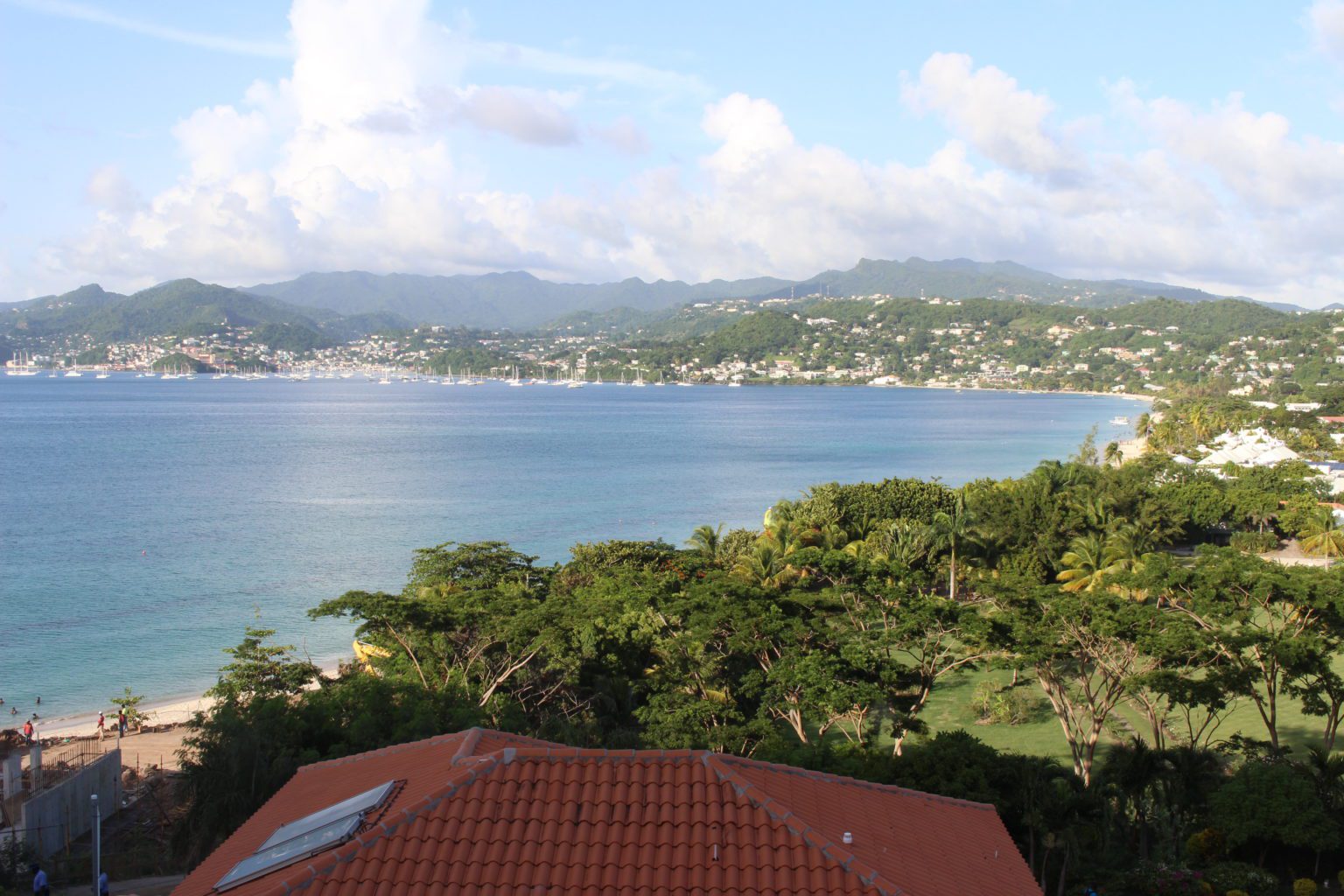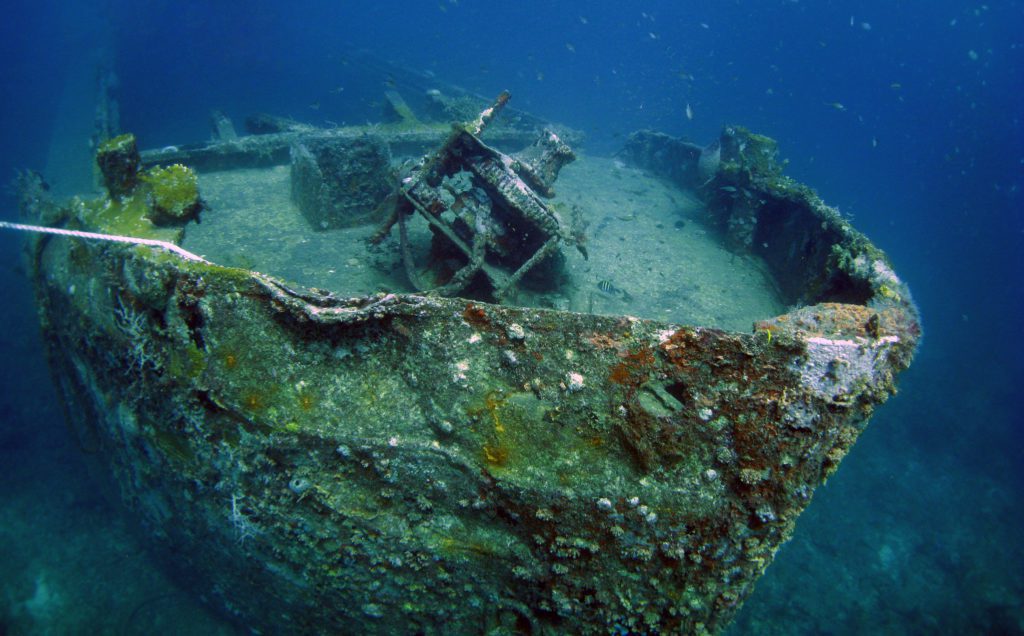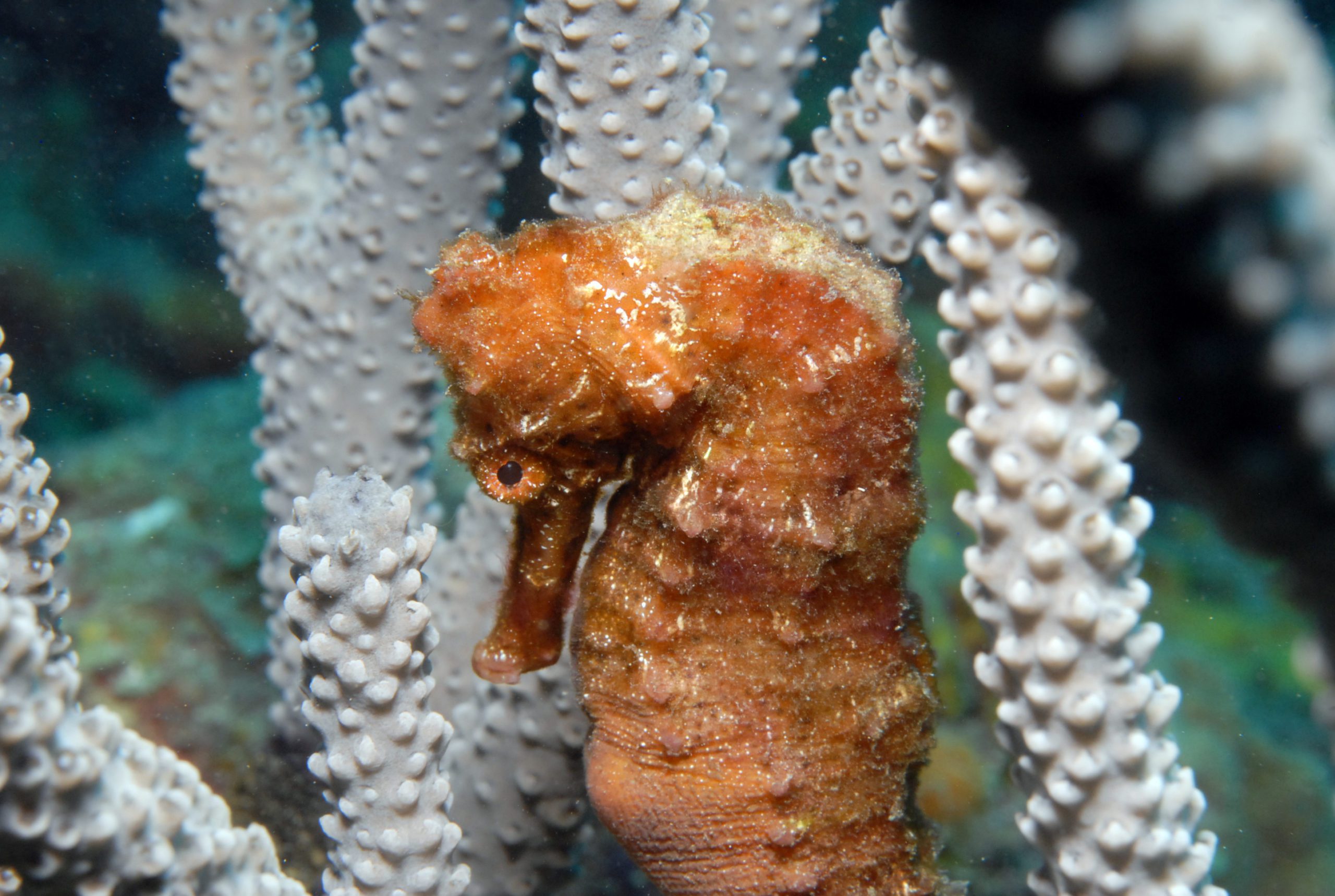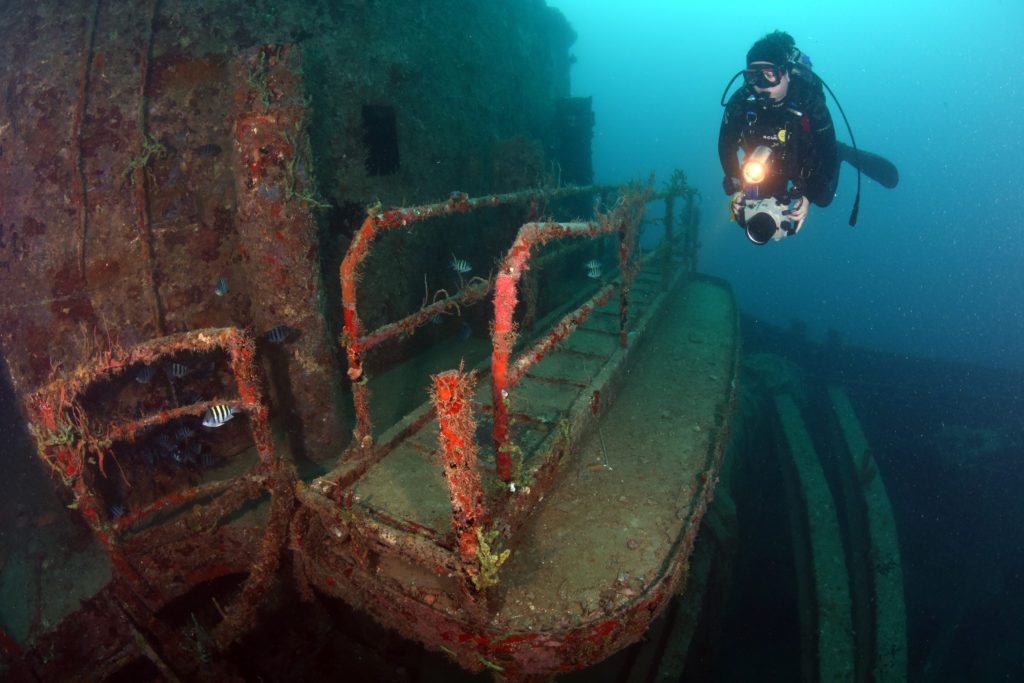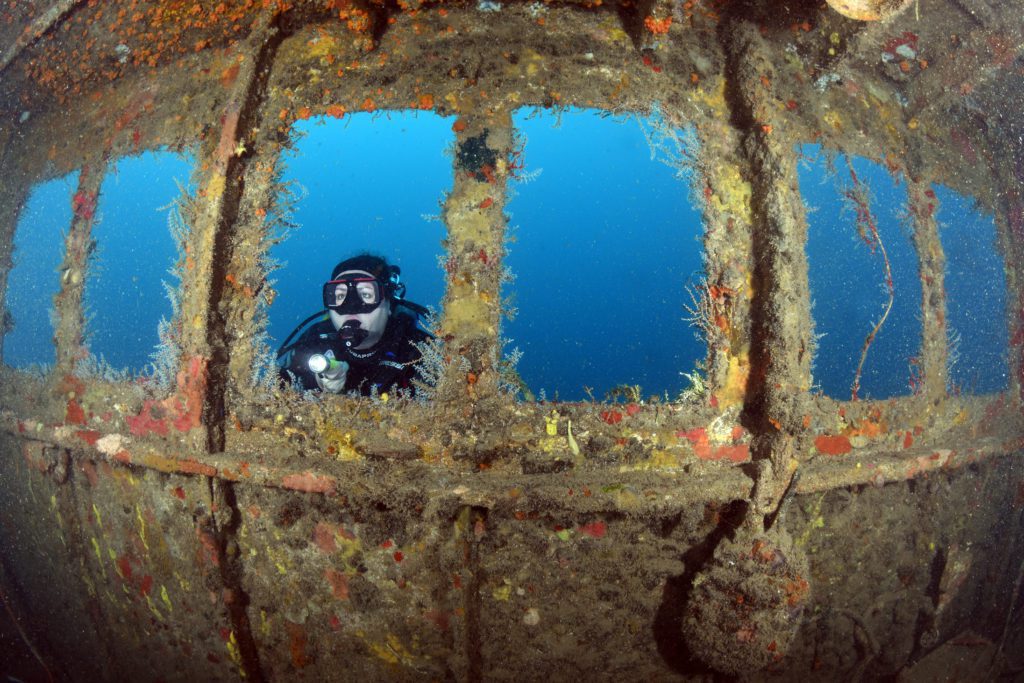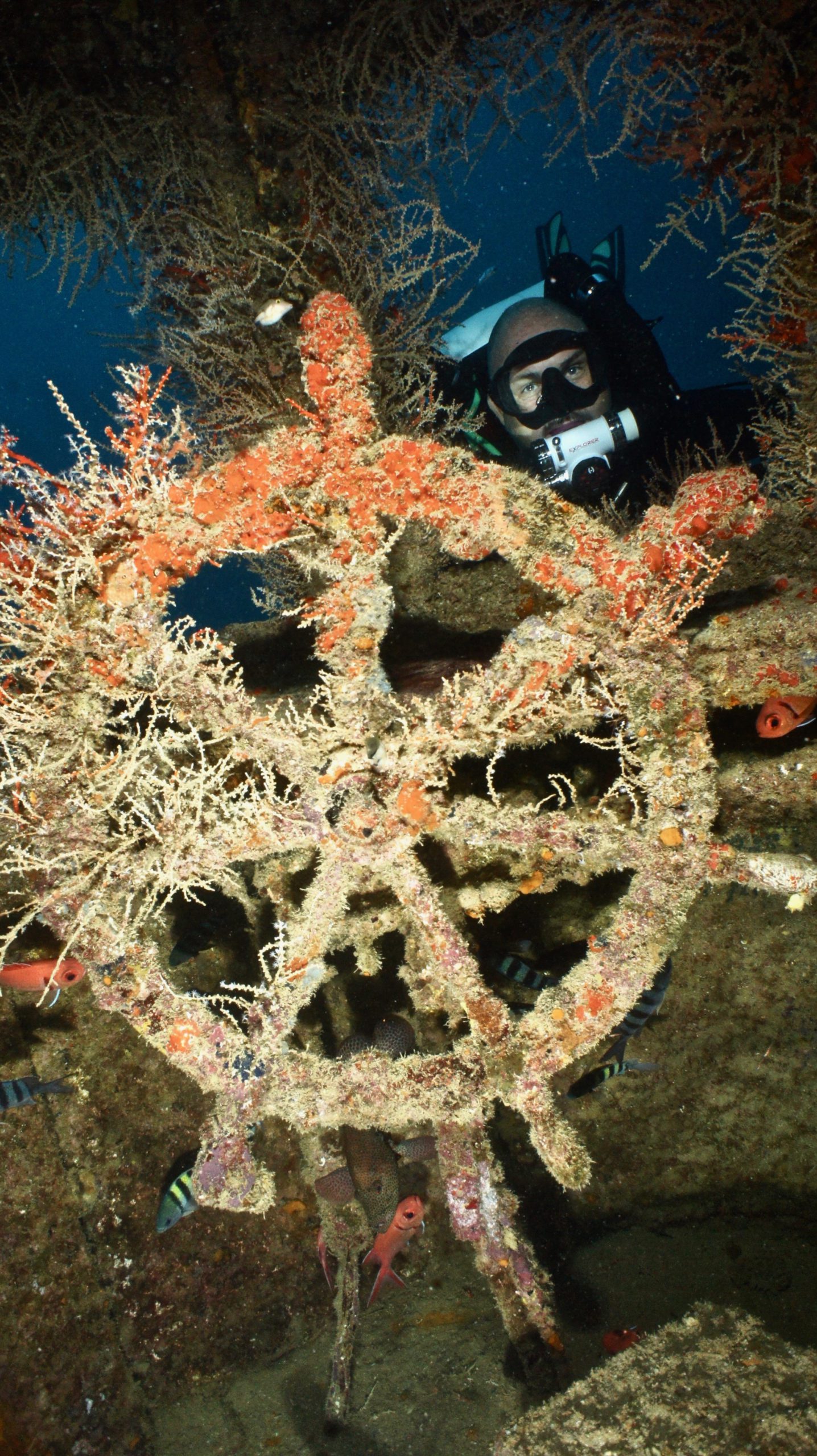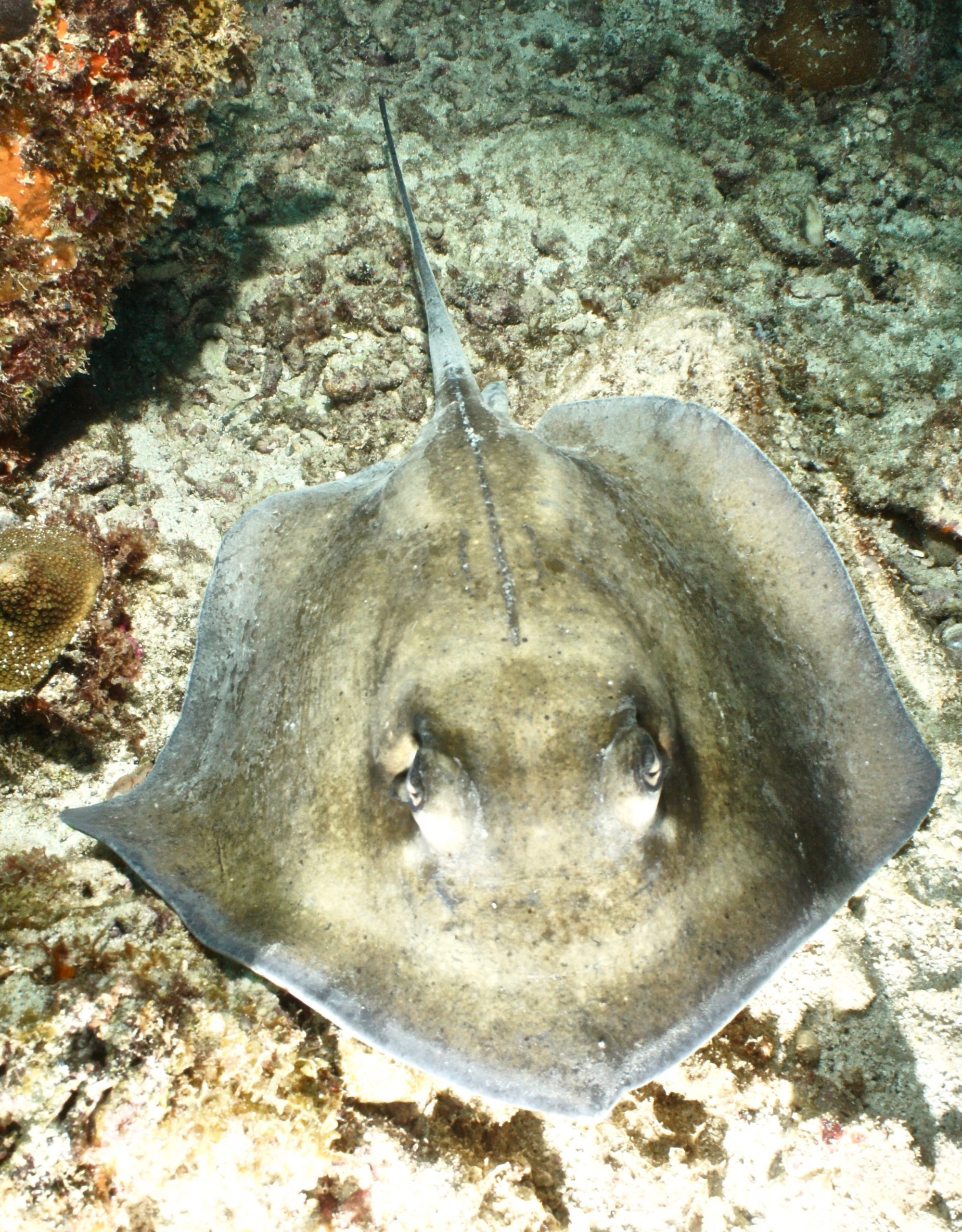Shipwreck Central
Grenada can quite rightly claim to be the ‘shipwreck capital of the Caribbean’, boasting a vast array of shipwrecks in depths to suit all levels of diver, and it is a firm favorite with dedicated ‘wreckie’ Mark Evans.
There are few countries globally that can compete with Grenada and Carriacou when it comes to shipwrecks, never mind just in the Caribbean, and even more incredibly, many of the sunken vessels were genuine maritime accidents, not purpose-sunk artificial reefs. And because the islands sit near a busy trade route, the number of wrecks is going up all the time!
This is fantastic news for divers, and whether you are a newly qualified open water diver, or a hardcore diving veteran, you will find a multitude of shipwrecks awaiting your visit. And if you aren’t into your sunken metal, never fear – the sheer amount of marine growth and fish life that lives on and around the wrecks means every dive is a swirling riot of vibrant color.
Titanic Of The Caribbean
You cannot talk about wreck diving in Grenada without first mentioning the mighty Bianca C, a gigantic 600-feet-long, 18,000-ton Italian liner which went down off the coast of Grenada in 1961.
The Bianca C was built in 1939 on the south coast of France, and then after being launched as an incomplete ship named Marechal Petain, was sunk by German forces in August 1944. The hull was raised in 1946 and taken back to its original shipyard, where it was refitted and launched as a cruise ship in 1949, bearing the name La Marseillaise.
She then became known as the Arosa Sky in 1957 after being sold, before finally, in 1959, she was bought by the G Costa du Genoa company, and was renamed Bianca C after a daughter in the family firm. She was tasked with the run from Naples, Italy, to Guaira in Venezuela, and Grenada was her last stop on the return leg.
On 22 October 1961, while anchored off St Georges, an explosion in the boiler room saw the vessel catch fire. Hordes of local boats – ranging from sailing boats, power boats and tiny dinghies to ocean-going yachts and inter-island trading schooners, even rowing boats – responded to the crisis, rescuing all but one person who perished on board. Sadly, of 12 badly burned crew, two other men died later. Showing the friendliness and generosity that Grenada is renowned for, all of the rescued passengers were given food and shelter in hotels, guest houses and even private homes.
British frigate HMS Londonderry was in Puerto Rico and sailed down to Grenada to assist. When the naval vessel arrived on 24 October, the Bianca C was still ablaze. The frigate managed to take the huge liner in tow, with an aim to move it away from the shipping lanes, but it proved problematic due to the Bianca C’s rudders being jammed and eventually the towing line snapped and the ship sank, which is how it came to rest upright in 165ft of water off Pink Gin Beach. Over 57 years on the seabed has taken its toll on the old girl, and she is deteriorating year on year, but there is no taking away from the epic scale of this enormous vessel, and she still makes a fine flagship for the rest of Grenada and Carriacou’s sunken fleet. It is still possible to make out key aspects of the ship, including the swimming pool, bollards, winches, parts of the superstructure and the bow chain and rope locker.
In terms of marine life, you often get large shoals of Atlantic spadefish cruising above the wreck, along with large barracuda, eagle rays and even the odd reef shark.
Accidental Shipwrecks
As said before, due to its location on various shipping routes, Grenada is also blessed with a plethora of shipwrecks that were the result of maritime accidents, and now provide underwater playgrounds for divers and protective habitats for marine life.
The 165-feet freighter Shakem was carrying much-needed bags of cement for the building industry on Grenada when she was caught in a storm in May 2001. The heavy cargo shifted and she went down, settling upright in 100ft.
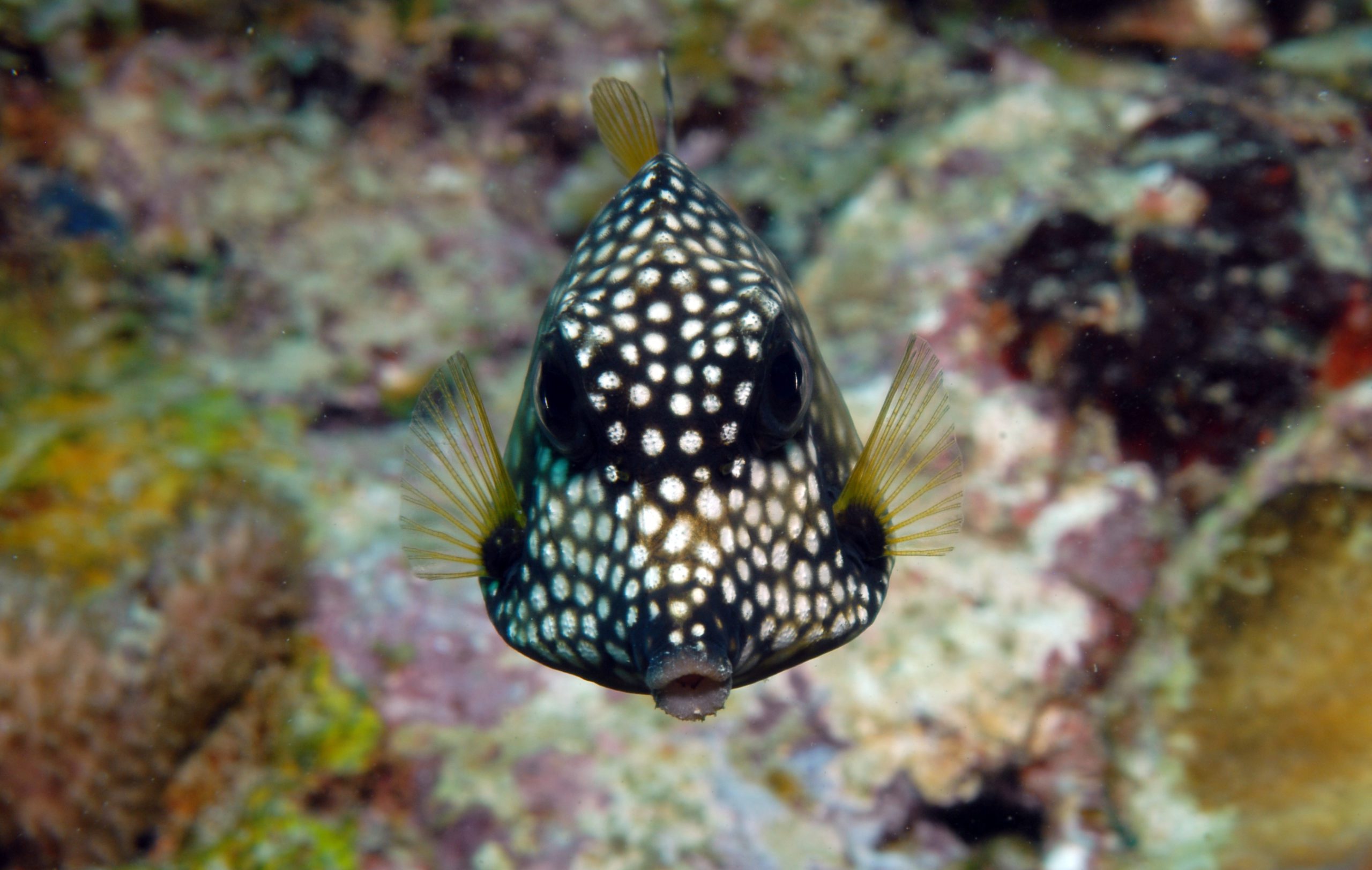
The remnants of the bags of cement can clearly be seen in the holds – the cement has set, and the bags have long since fallen apart, leaving giant ‘pillows’ stacked neatly in piles – but her real draw is the rich smothering of coral and sponge growth that seems to cover every square inch of her hull, superstructure and especially the large crane lying amidships.
This is liberally covered in gorgonian sea fans, while the rear of the ship almost looks like a fluffy white wall dive due to the thick coating of coral.
Smaller than the Shakem at a length of 130 feet, the Veronica L is a freighter which sank after springing a leak, but was then raised and moved to a location near Grande Anse after work began on the cruise ship dock. Now lying in 50ft, she is a perfect wreck dive for all levels, and is adorned in marine growth and fish life.
If you want to get a little more depth, you can even follow anchor chains off the stern down to a small drop-off at a depth of 100ft. The Atlantic side of Grenada – which is often rougher, with large swells, but also benefits from having tremendous visibility – is home to several world-class shipwrecks.
The King Mitch makes for an unusual wreck dive, given that she resembles a box with a pointed front! Originally a US Navy minesweeper from World War Two, she was retro-fitted into a freighter by having two cargo holds inserted in her middle, with a crane attached to the deck between them.
She lies several miles offshore on her side in just over 100ft, and sank in 1981 when her bilge pump failed. There is some coral growth on her, but as the wrecks on this side of the island are often swept by sometimes fierce currents, it is nowhere near as prolific and dense as on the Caribbean side. What it does have is nurse sharks, lots of them, and southern stingrays, not to mention patrolling barracuda and amber jack.
A little closer to land is the cargo vessel Hema 1, which had delivered a consignment of cement to the island and was enroute back to Trinidad on 1 March 2005 when she was also the victim of a failed bilge pump and ended up in 100ft of water. Shortly after being sunk, she was broken apart by hurricane surge, and now the hull and bow lie on their port side, with the midships well flattened.
This wreck is another haunt for nurse sharks, which swarm in large numbers under hull plates and near the bow, and reef sharks sometimes pay a fleeting visit from out of the blue.
The latest vessel to join Grenada’s underwater fleet on the Atlantic side was the Persia II, which went down in 115ft in March 2017. Coral growth on this cargo ship is fairly sparse at the moment, but algae has taken a hold, and marine life has already started to move in, with various reef fish and the invasive lionfish in residence.
Being some eight miles offshore means currents can be strong, and she lies close to deep water, so only time will tell what will eventually call her home, but in the meantime, divers can enjoy seeing a ship in the early stages of being claimed by the sea.
Artificial Reefs
Not that they necessarily need it with such a selection of genuine shipwrecks, but Grenada and Carriacou also boast several artificial reefs, and more are in the pipeline.
Grenada has the Buccaneer, a sloop sunk way back in 1978 that lies on its starboard side in just 78ft and is well-festooned with marine growth. She is only small, but home to plenty of fish life, and her compact nature makes her perfect for photography.
The cargo ship MV Hildur has been down since 2007 and lies in Grand Mal Bay in 115ft. Like the Buccaneer, she has collected a thick layer of encrusting coral and sponge growth in her time on the bottom, and her large open holds provide the perfect environment for shoals of fish. Spadefish and barracuda often swim in the water above her.
The 196-foot container ship Anina languished in Grand Anse Bay for several years before finally being green-lighted as an artificial reef, but she ended up going down slightly earlier than planned at the end of March 2018 after starting to take on water and can be found lying on her side in some 100ft of water close to popular reef dive Purple Rain.
It is a stunning dive, with the flat bottom of the vessel liberally coated in orange cup corals – so much so it resembles a wall dive – and the cavernous holds being open for exploration. It is also possible to venture into the engine room, which retains much of its machinery.
The latest wreck was the Tyrrel Bay, a former US Coastguard patrol boat which went down at the end of September 2018 close to Boss Reef off Grand Anse Beach. The result of a two-year public/private sector project, the wreck still has many interesting features, including a safe, telephone, compasses, control panels and levers, and even a few toilets, and its shallow depth – the upper superstructure comes to within 15ft of the surface – means it can be enjoyed by all levels of diver, and even snorkelers/freedivers.
On Carriacou near Mabouya Island, you have the Twin Tugs, two vessels sitting within a short distance of one another in 90ft-100ft, though for a thorough exploration of both, they are best visited individually due to the depth. Both are around 100 feet in length – the Westsider was sent to the bottom on 4 September 2004, and the Boris followed on 10 September 2007.
The two wrecks are covered in vibrant red and orange encrusting corals and algae and penetration into the interior is possible on both. Currents can sometimes sweep across them, and they are home to angelfish, wrasse, soldierfish, lobster and moray eels.
This duo were joined in January 2018 by the 125-foot tugboat Mammoth Troll. The Troll, as it is known, was set to go down near the Twin Tugs, but it is now on the bottom in 115ft in an upright position a short distance from the famed Sisters Rocks. Penetration is possible into various sections of the vessel, and there is a great swim-through running the length of the superstructure on the starboard side.
Over 57 years on the seabed has taken its toll on the old girl, and she is deteriorating year on year, but there is no taking away from the epic scale of this enormous vessel, and she still makes a fine flagship for the rest of Grenada and Carriacou’s sunken fleet
The result of a two-year public/private sector project, the wreck still has many interesting features, including a safe, telephone, compasses, control panels and levers, and even a few toilets
Did you know? - Mount Saint Catherine, at 2,756 feet, is the highest mountain in Grenada.
Chasing waterfalls - Grenada has several fantastic waterfalls, though only a handful are known to the general public. The nearest to the capital, St George’s, is the Annandale Waterfalls, but other ones of note include Mt Carmel, Concord, Seven Sisters and Tufton Hall.
Did you know? - Grenada boasts the oldest functioning water-propelled distillery in the Caribbean – River Antoine Rum Distillery.
Good to know - Wearing camouflage – considered the army’s uniform – is considered a crime, so leave those camo shorts at home.
More Than Wrecks
Grenada and Carriacou are also blessed with a vast array of reef dives, boasting some of the most-healthy and pristine corals anywhere in the Caribbean, so if you are not a metal-head, never fear, these islands have still got you covered.
Grenada and Carriacou have a multitude of reef dives, ranging in depth from just a few feet to some in the technical arena – in fact, between the two islands, you have such a selection you could probably spend a month or more here and not have to hit the same site twice. Most of the dive sites are located on the west and south side of both Grenada and Carriacou; some sites are very sheltered, with little or no current, while others are more exposed and can be subject to quite extreme currents at times.
Purple Rain is widely regarded as one of the most-pristine reefs on Grenada. The reef ranges in depth from 20ft-80ft, and it is explored as a drift, but how fast you go can vary. On one visit it may be a mild current, gently pushing you along the sloping reef, on another, you can be in for a fast ride as the current roars along. The name comes not from the song by the late, diminutive pop star, but from the clouds of vivid purple Creole wrasse that swarm in the waters above the corals and sponges.
Shark Reef is only 40ft-60ft in depth, but the draw is where it is located – just south of Glovers Island on the Atlantic side of Grenada. Generally swept by current, it makes for an interesting drift dive, as you pass through large shoals of snapper and grunts and big patches of sponges and soft corals, keeping an eye out for lobster and huge crabs sheltering in crevices and caves in the reef. Trigger fish, angelfish and parrotfish are also common, and you can usually see the odd nurse shark, which is what gave the site its name.
Grenada has a Marine Protected Zone that the islanders are very proud of, and within this area there are a number of dive sites. Flamingo Bay lies in the northern most part of the MPA and is regarded as one of the top spots to visit. The reef goes from 20ft down to around 80ft-90ft, and is covered in elkhorn coral and ball, rope, vase and barrel sponges. Angelfish, damselfish, butterflyfish, parrotfish and trumpetfish swim in among this vibrant habitat.
Happy Valley has similar depths to Flamingo Bay, and is located in the middle of the MPA. It is a truly stunning dive – what starts as a sloping reef rapidly becomes a wall, pockmarked with holes usually occupied by lobster, and an array of huge corals and sponges. Shoaling baitfish fill cuts in the wall, and jacks stalk them through the whip corals. Embedded into the reef, and totally encrusted with coral growth, is a large Admiralty anchor from days gone by.
Dragon Bay is also within the MPA, and comprises a series of sand channels that drop down and out towards a gently sloping reef. Maxing out at 75ft, the sand is home to garden eels, flounder and southern stingrays, while the thick forests of soft corals and sponges on the fingers of reef shelter spotted drums, seahorses, filefish and trumpetfish.
Molinere Reef is another pretty dive site in the MPA, but as well as the topographically interesting reef, which is shaped by gullies, crevices and sand channels, and also a small wall, the main attraction here is the Underwater Sculpture Park, the first of its kind on the planet, which opened in May 2006. Ranked in the Top 25 ‘Wonders of the World’ by National Geographic, this underwater work of art sees several large-scale installations in just a few feet of water, including Vicissitudes, a circle of life-size figures cast from local children linked by holding hands; The Lost Correspondent, which is a man working at his desk on a typewriter; The Un-Still Life, a classical still-life composition of a vase and bowl of fruit on a table; and the Nutmeg Princess, which sees a life-size figure ‘growing’ out of a nutmeg pod. Created by Jason deCaires Taylor, Troy Lewis, Rene Froehlich and Lene Kilde, the amazingly lifelike statues have started to assume bizarre alien-like appearances as encrusting corals and sponges have taken hold. Shallow enough to be experienced by snorkelers, this is one site that needs to be appreciated by all divers.
Wibbles Reef is a fairly deep reef, extending from 50ft-85ft, and it is generally tagged on to the end of a dive on the Bianca C, as once you drift off the bow of this giant, you can start heading upwards and pick up the reef on your way. It makes a nice dive in its own right, and as it is often swept by a current, it makes for a relaxing drift dive – you just set your buoyancy, then sit back and enjoy the ride, taking in the scenery as you go. Turtles, eagle rays, jacks and barracuda are often encountered along the way, and the sponge growth, particularly of barrel varieties, is impressive.
Over on Carriacou, you have the Sisters, which is one of the most-famous dive sites on the islands. These two rock pinnacles are often swept by strong currents, and this means they have phenomenal coral growth, as well as a diverse mix of marine life. There are actually two dive sites, Deep Blue – which features a wall that drops to 130ft – and Barracuda Point, and both can be extremely challenging if the current is running, but this is when you get the major displays of shoaling fish.
Tropical Hill is a seamount rising up from 60ft to just below the surface, and it is absolutely teeming with life. Wide cracks running several feet upwards on the rock face can be jam-packed with lobster, while shoals of Creole wrasse and snapper swarm in and around the large gorgonian sea fans and sponges protruding out into the nutrient-rich water. Turtles are often found mooching around in the shallows.
White Sand Beach is a relaxing shallow dive, no deeper than 40ft, which basically entails cruising around several large rock formations that are covered in coral growth and large sponges, making them a perfect habitat for juvenile reef fish, and exploring the sand patches between, which are home to jawfish, garden eels, southern stingrays and occasional turtles.
If you are after an adrenalin-rush, then Layer Cake is just the ticket. Located off the south of the island, it comprises a rapid drift along a gently sloping reef which then becomes ‘stepped’ like a wedding cake, but with deep undercuts and overhangs that you can shelter in momentarily out of the current before heading back out into the maelstrom. Nurse sharks and moray eels are often seen as you fly over the reef.
Ranked in the Top 25 ‘Wonders of the World’ by National Geographic, this underwater work of art sees several large-scale installations in just a few feet of water
Wide cracks running several feet upwards on the rock face can be jam-packed with lobster, while shoals of Creole wrasse and snapper swarm in and around the large gorgonian sea fans and sponges protruding out into the nutrient-rich water
Fun fact - Constructed by the French in 1779, Fort Frederick was soon used – paradoxically – by the British to defend against the French. It’s the island’s best-preserved fort, and offers striking panoramic views.
Did you know? - Grenada is also known as the ‘Spice Island’ because of the production of nutmeg and mace crops, of which it is one of the world’s largest exporters.
Culinary delights - The national dish of Grenada is Oil down, a combination of breadfruit, coconut milk, turmeric, dumplings, callaloo, and salted meat such as saltfish (cod), smoked herring or salt beef.
WHAT YOU NEED TO KNOW - Grenada.
Getting There
There are regular non-stop flights from New York and Miami into Grenada. To get to Carriacou, you can either take a short inter-island charter flight, or venture there by ferry.
When To Go
You can dive Grenada all year round, though the dry season falls between January and May, and the rainy season from June to December.
Currency
The currency in Grenada is the Eastern Caribbean dollar, but the US dollar is accepted, and many resorts and liveaboards will take payment by credit card.
Entry Requirements
Visitors need to have a valid passport with at least six months remaining, and a return air ticket.
Electricity 220 volt with UK-style three-pin sockets – you will need an adaptor to use standard US-type sockets
Photographs by Mark Evans
